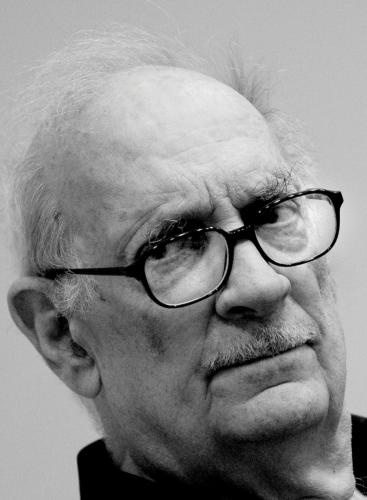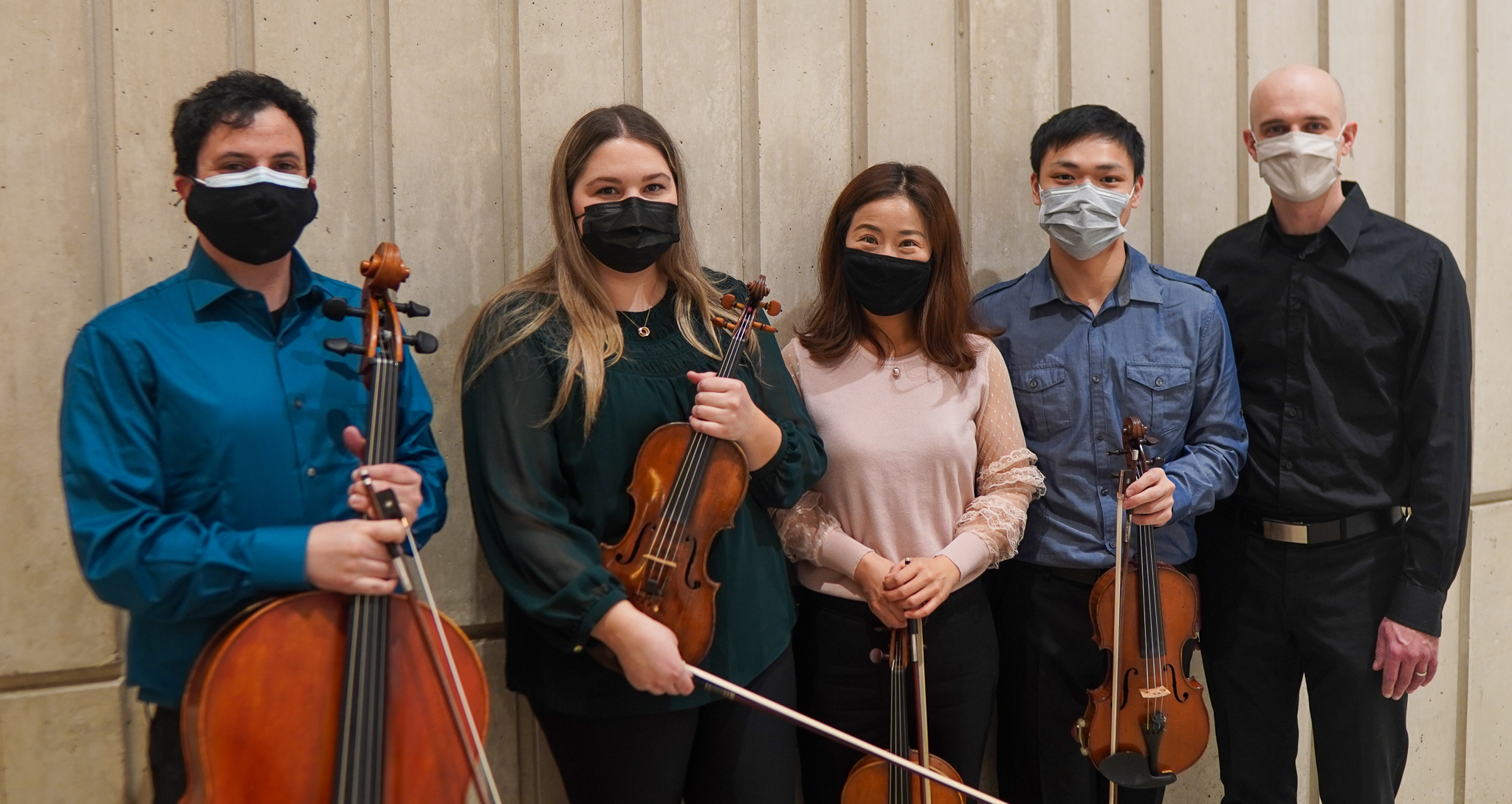CNM Ensemble Concert III
Sunday, February 21, 2021 at 7:30p in the Concert Hall
Program
|| download program ||
Creature Quartet (2014) |
Laura SCHWENDINGER |
| Luciana Hontila, violin ShengHo Wang, violin Donghee Han, viola Adrian Gomez Hernandez, violoncello |
Music for a Summer Evening (Makrokosmos III) (1974) |
George CRUMB |
|
Yi Wang, piano |
|
Creature Quartet is my personal response to the current mass extinction of species. It is composed of eleven short movements, each a paean, or character portrait in music of an extinct, mythological, or endangered creature. The work starts and ends with a “hymn for lost creatures,” which comes back in various forms between movements. Relationships exist as well, between movements; the repeated pattern of the Ivory Billed Woodpecker (1), in pizzicato (plucked strings) and col legno (wood of bow), returns altered in Javan Rhinoceros (VII), but in a more aggressive style, returning in yet another altered state in Thylacine (X), in an active, agile manner. The music in Passenger Pigeon (II) is characterized by tremolando figures (shifting bow), which represents a nostalgic look back at the mysterious flight of the large flocks of birds that filled once the skies. This is also hinted at through chromatic transformation and tremolando in Yeti (IV), where it is now very mysterious and quiet. When the Yeti is finally seen, it growls a very loud chord in tremolando. The sad and poignant music of Dodo Bird (III) is expressed in solo viola, with awkward pizzicato accompaniment, reflecting the image we have of this large, flightless bird; and, in turn, is referenced again in inversion in Lowland Gorilla (IX). The Gorilla is depicted in solo cello, which moves from the instrument’s lower register, through a high singing line, again accompanied by awkward pizzicatos and aggressive tremolando, culminating as the Gorilla beats his chest. The music of Chupacabra (V) has its own distinctive creepy, nocturnal character. The animal’s stalking, captured in trills and piercing harmonics (the red of the animal’s eyes), jumping out of the frenzied texture. This character is amplified for The Tasmanian Devil (VIII), when the strings play frenzied lines in sul ponticello (over the bridge). At the end of the movement, loud growling sounds are heard which evoke the actual voice of the Taz Devil. |
|
Laura Elise Schwendingeris the first composer to win the American Academy in Berlin Prize. Her music has been performed by world-class ensembles and artists, including the Franz Liszt Chamber Orchestra, New Juilliard Ensemble, Dawn Upshaw, Eighth Blackbird, Boston Musica Viva, the Arditti Quartet, and the American Composers Orchestra, among others. She has been the League of American Orchestras Composer in Residence with the Richmond Symphony. Her numerous honors also include awards from the Guggenheim, Koussevitzky (2), and Fromm Foundations; the Copland House, Harvard Musical Associations, Chamber Music America, and two American Academy of Arts and Letters awards. Schwendinger’s first Koussevitzky Commission performance was played at the Berlin Philharmonie and featured violinist Janine Jansen. Her music has been described as “evince(ing) an acute sonic imagination and sure command of craft” (Chicago Tribune), “darkly attractive, artful and moving…” (New York Times), and “shrewd composing, the genuine article. Onto the ‘season’s best’ list it goes.” (Boston Globe). Laura Schwendinger is Professor of Composition at the University of Wisconsin at Madison. |
|
Music for a Summer Evening (Makrokosmos III), for two amplified pianos and percussion, was completed in February 1974. The work was commissioned by the Fromm Foundation. The combination of two pianos and percussion instruments was, of course, first formulated by B la Bart k in the Sonata of 1937, and it is curious that other composers did not subsequently contribute to the genre. Bart k was one of the very first composers to write truly expressive passages for the percussion instruments; since those days there has been a veritable revolution in percussion technique and idiom and new music has inevitably assimilated these developments. The battery required for Summer Evening is quite extensive. Certain rather exotic (and in some cases, quite ancient) instruments are occasionally employed for their special timbral characteristics. The kaleidoscopic range of the percussion timbre is integrated with a great variety of special sounds produced by the pianists. As in several of my other works, the musical fabric of Summer Evening results largely from the elaboration of tiny cells into a sort of mosaic design. In its overall style, Summer Evening might be described as either more or less atonal, or more or less tonal. The more overtly tonal passages can be defined in terms of the basic polarity of F#-D# minor. One other structural device which the astute listener may perceive is the isorhythmic construction of “Myth,” which consists of simultaneously performed taleas of 13, 7, and 11 bars. I feel that Summer Evening projects a clearly articulated large expressive curve over its approximately forty-minute duration. The first, third, and fifth movements, which are scored for the full ensemble of instruments and lead out on a large scale, would seem to define the primary import of the work (which might be interpreted as a kind of “cosmic drama”). On the other hand, “Wanderer Fantasy” (mostly for the two pianos alone) and the somewhat atavistic “Myth” (for percussion instruments) were conceived of as dream-like pieces functioning as intermezzos within the overall sequence of movements.” The three larger movements carry poetic quotations which were very much in my thoughts during the sketching-out process, and which, I believe, find their symbolic resonance in the sounds of Summer Evening. “Nocturnal Sounds” is inscribed with an excerpt from Quasimodo: “Odo risonanze effimere, oblio di piena note nell’acqua stellata” (“I hear ephermeral echoes, oblivion of full night in the starred water”); “The Advent” is associated with the passage from Pascal: “Le silence eternal des espaces infinis m’effraie” (“The eternal silence of infinite space terrifies me”); and the last movement, “Music of the Starry Night,” cites these transcendently beautiful images of Rilke: “Und in den Nächten fällt die schwere Erde aus allen Sternen in die Einsamkeit. Wir alle fallen. Und doc hist Iener, welcher deises Fallen unendlich sanft in seinen Händen hält” (And the nights the heavy earth is falling from all the starts down into loneliness. We are all falling. And yet there is One who holds this falling endlessly gently in His hands.”) |

George Crumb (b. 1929) is one of the most frequently performed composers in today’s musical world. Crumb is the winner of Grammy and Pulitzer Prizes and continues to compose new scores that enrich the lives of all who come in contact with his profoundly humanistic art. Crumb’s music often juxtaposes contrasting musical styles, ranging from music of the Western art-music tradition, to hymns and folk music, to non-Western musics. Many of Crumb’s works include programmatic, symbolic, mystical and theatrical elements, which are often reflected in his beautiful and meticulously notated scores. A shy, yet warmly eloquent personality, Crumb retired from his teaching position at the University of Pennsylvania after more than thirty years of service. Honored by numerous institutions with honorary Doctorates, and the recipient of dozens of awards and prizes, Crumb makes his home in Pennsylvania, in the same house where he and his wife of more than sixty years raised their three children. George Crumb’s music is published by C. F. Peters and an ongoing series of “Complete Crumb” recordings, supervised by the composer, is being issued on Bridge Records. |


|